Hyundai Kona vs Mazda MX-30 – Which model is better for everyday use?
Compare performance, boot capacity, efficiency and price at a glance.
Find out which car is the better choice for you – Hyundai Kona or Mazda MX-30?
Costs and Efficiency:
Price and efficiency are key factors when choosing a car – and this is often where the real differences emerge.
Hyundai Kona has a noticeable advantage in terms of price – it starts at 23100 £, while the Mazda MX-30 costs 30800 £. That’s a price difference of around 7791 £.
In terms of energy consumption, the advantage goes to the Hyundai Kona: with 14.60 kWh per 100 km, it’s noticeable more efficient than the Mazda MX-30 with 18.30 kWh. That’s a difference of about 3.70 kWh.
As for range, the Hyundai Kona performs convincingly better – achieving up to 514 km, about 429 km more than the Mazda MX-30.
Engine and Performance:
Under the bonnet, it becomes clear which model is tuned for sportiness and which one takes the lead when you hit the accelerator.
When it comes to engine power, the Hyundai Kona has a evident edge – offering 218 HP compared to 170 HP. That’s roughly 48 HP more horsepower.
In acceleration from 0 to 100 km/h, the Hyundai Kona is slightly quicker – completing the sprint in 7.80 s, while the Mazda MX-30 takes 9.10 s. That’s about 1.30 s faster.
In terms of top speed, the Hyundai Kona performs evident better – reaching 210 km/h, while the Mazda MX-30 tops out at 140 km/h. The difference is around 70 km/h.
Space and Everyday Use:
Cabin size, boot volume and payload all play a role in everyday practicality. Here, comfort and flexibility make the difference.
Both vehicles offer seating for 5 people.
In curb weight, Hyundai Kona is evident lighter – 1370 kg compared to 1849 kg. The difference is around 479 kg.
In terms of boot space, the Hyundai Kona offers evident more room – 466 L compared to 350 L. That’s a difference of about 116 L.
In maximum load capacity, the Hyundai Kona performs to a small extent better – up to 1300 L, which is about 145 L more than the Mazda MX-30.
When it comes to payload, Hyundai Kona slightly takes the win – 490 kg compared to 402 kg. That’s a difference of about 88 kg.
Who wins the race?
The Hyundai Kona proves to be wins the duel decisively and therefore becomes our DriveDuel Champion!
Hyundai Kona is the better all-rounder in this comparison.
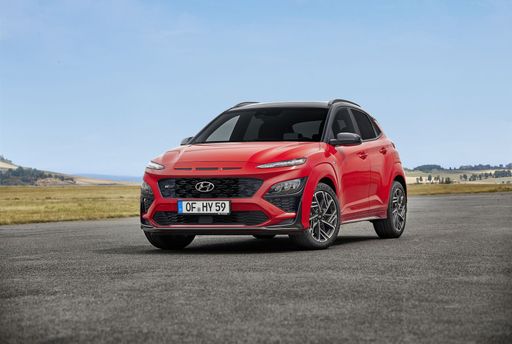
Hyundai Kona
Hyundai Kona
The Hyundai Kona blends a bold design with a versatile interior, making it a standout choice in the compact SUV market. Its crisp handling and responsive steering provide an engaging driving experience, whether in the city or on the open road. The vehicle also offers a range of features designed to enhance comfort and connectivity, ensuring a pleasurable journey for both driver and passengers.
details @ hyundai.news
@ hyundai.news
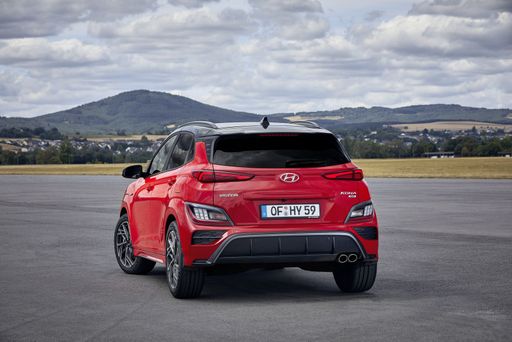 @ hyundai.news
@ hyundai.news
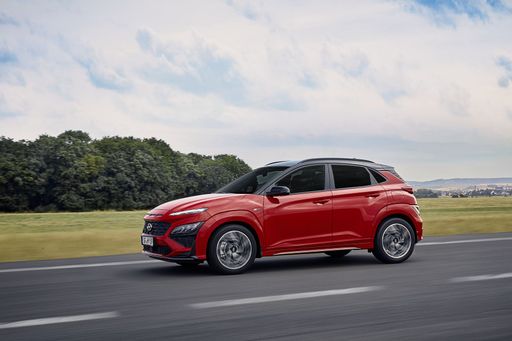 @ hyundai.news
@ hyundai.news
 @ hyundai.news
@ hyundai.news
Mazda MX-30
The Mazda MX-30 is a compact crossover that combines unique design with an environmentally conscious approach. Its distinct exterior features a coupe-like silhouette and freestyle doors that offer practicality and style. Inside, the cabin boasts sustainable materials, creating a harmonious blend of modern aesthetics and eco-friendly innovation.
details @ de.mazda-press.com
@ de.mazda-press.com
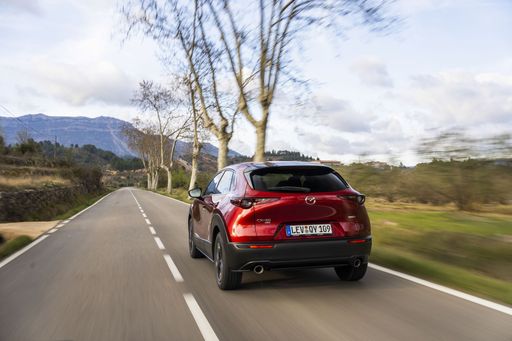 @ de.mazda-press.com
@ de.mazda-press.com
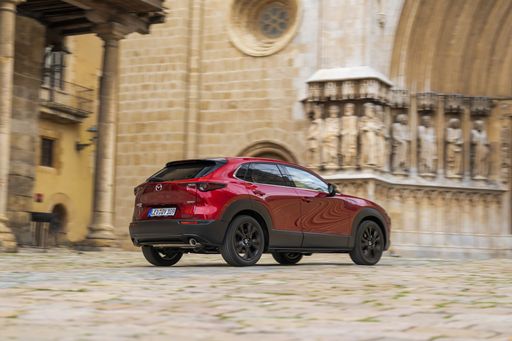 @ de.mazda-press.com
@ de.mazda-press.com
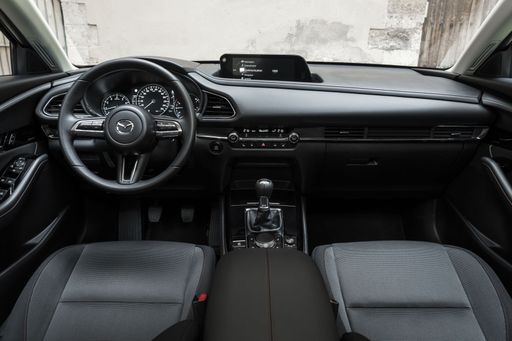 @ de.mazda-press.com
@ de.mazda-press.com

|

|
|
|
|
Costs and Consumption |
|
|---|---|
|
Price
23100 - 41600 £
|
Price
30800 - 37100 £
|
|
Consumption L/100km
4.6 - 7 L
|
Consumption L/100km
-
|
|
Consumption kWh/100km
14.6 - 16.8 kWh
|
Consumption kWh/100km
18.30 kWh
|
|
Electric Range
377 - 514 km
|
Electric Range
85 km
|
|
Battery Capacity
1.3 - 65.4 kWh
|
Battery Capacity
-
|
|
co2
0 - 163 g/km
|
co2
22 g/km
|
|
Fuel tank capacity
38 - 47 L
|
Fuel tank capacity
-
|
Dimensions and Body |
|
|---|---|
|
Body Type
SUV
|
Body Type
SUV
|
|
Seats
5
|
Seats
5
|
|
Doors
5
|
Doors
5
|
|
Curb weight
1370 - 1773 kg
|
Curb weight
1849 kg
|
|
Trunk capacity
466 L
|
Trunk capacity
332 - 350 L
|
|
Length
4350 - 4385 mm
|
Length
4395 mm
|
|
Width
1825 mm
|
Width
1848 mm
|
|
Height
1580 - 1585 mm
|
Height
1555 mm
|
|
Max trunk capacity
1300 L
|
Max trunk capacity
1137 - 1155 L
|
|
Payload
420 - 490 kg
|
Payload
402 kg
|
Engine and Performance |
|
|---|---|
|
Engine Type
Electric, Petrol, Full Hybrid
|
Engine Type
Plugin Hybrid
|
|
Transmission
Automatic, Manuel
|
Transmission
Automatic
|
|
Transmission Detail
Manual Gearbox, Dual-Clutch Automatic
|
Transmission Detail
Reduction Gearbox
|
|
Drive Type
Front-Wheel Drive, All-Wheel Drive
|
Drive Type
Front-Wheel Drive
|
|
Power HP
115 - 218 HP
|
Power HP
170 HP
|
|
Acceleration 0-100km/h
7.8 - 11.9 s
|
Acceleration 0-100km/h
9.10 s
|
|
Max Speed
162 - 210 km/h
|
Max Speed
140 km/h
|
|
Torque
200 - 265 Nm
|
Torque
-
|
|
Number of Cylinders
3 - 4
|
Number of Cylinders
-
|
|
Power kW
85 - 160 kW
|
Power kW
125 kW
|
|
Engine capacity
998 - 1598 cm3
|
Engine capacity
830 cm3
|
General |
|
|---|---|
|
Model Year
2024 - 2025
|
Model Year
2025
|
|
CO2 Efficiency Class
A, D, C, E, F
|
CO2 Efficiency Class
B
|
|
Brand
Hyundai
|
Brand
Mazda
|
Is the Hyundai Kona offered with different drivetrains?
Available configurations include Front-Wheel Drive or All-Wheel Drive.
The prices and data displayed are estimates based on German list prices and may vary by country. This information is not legally binding.
